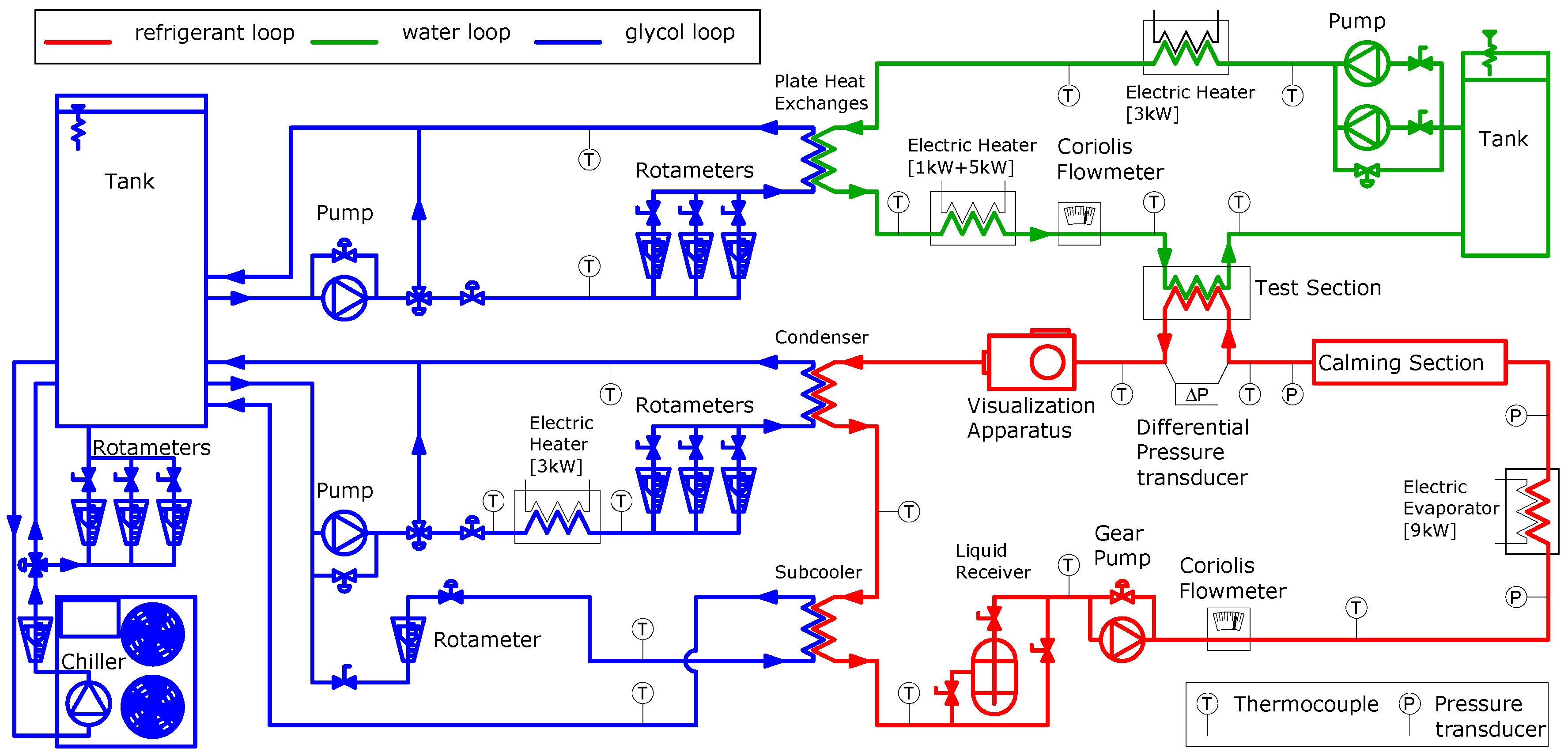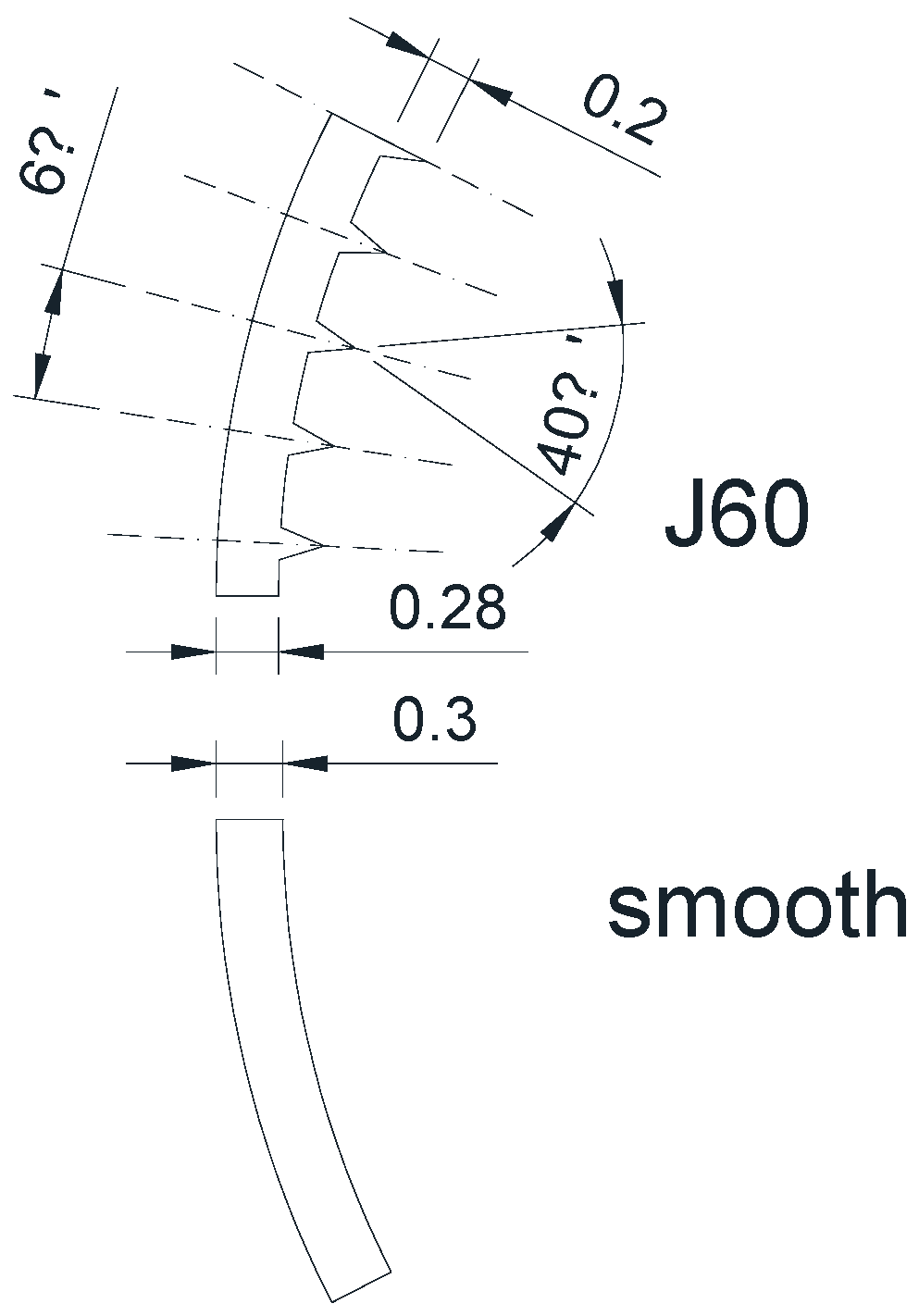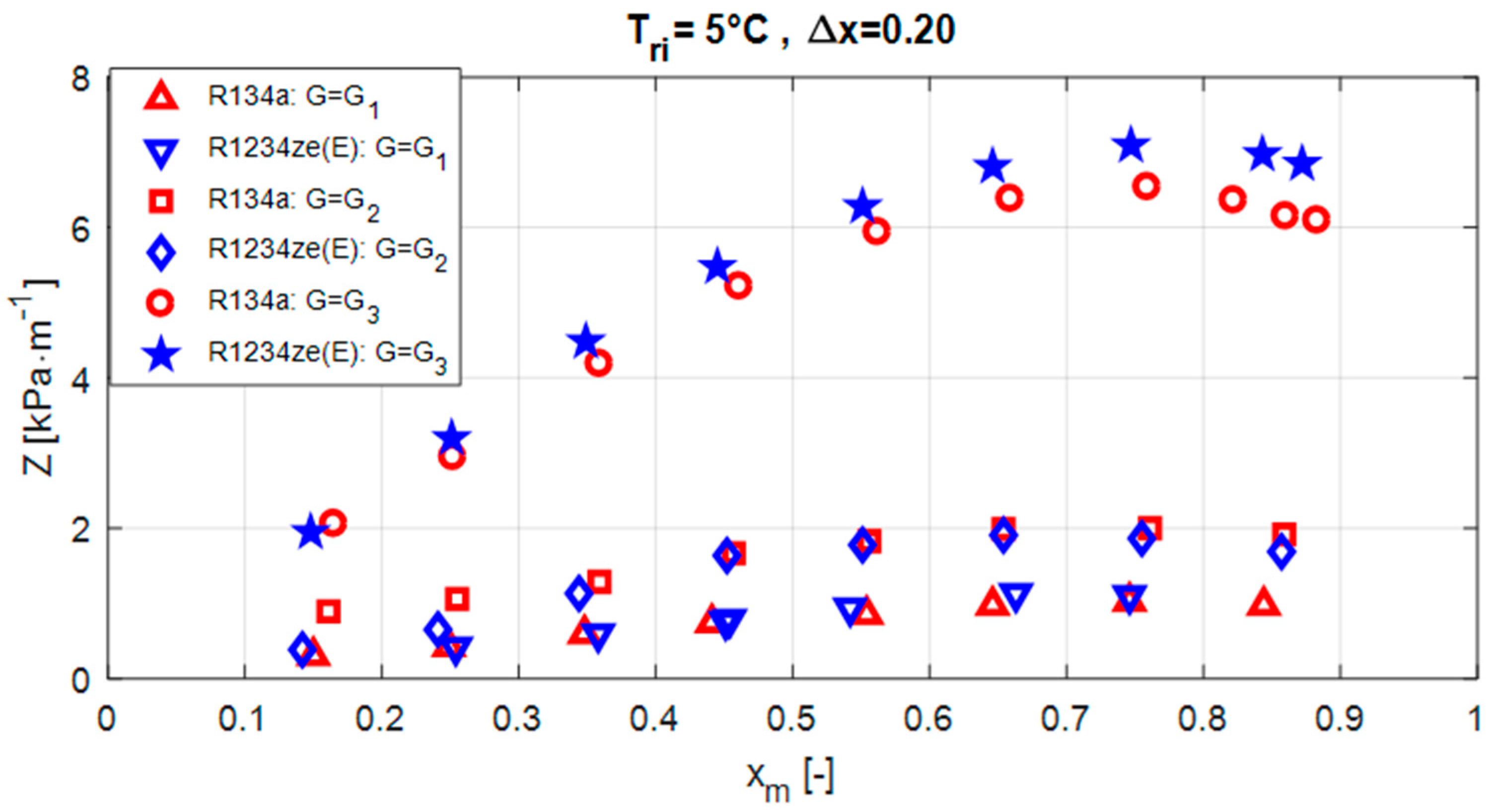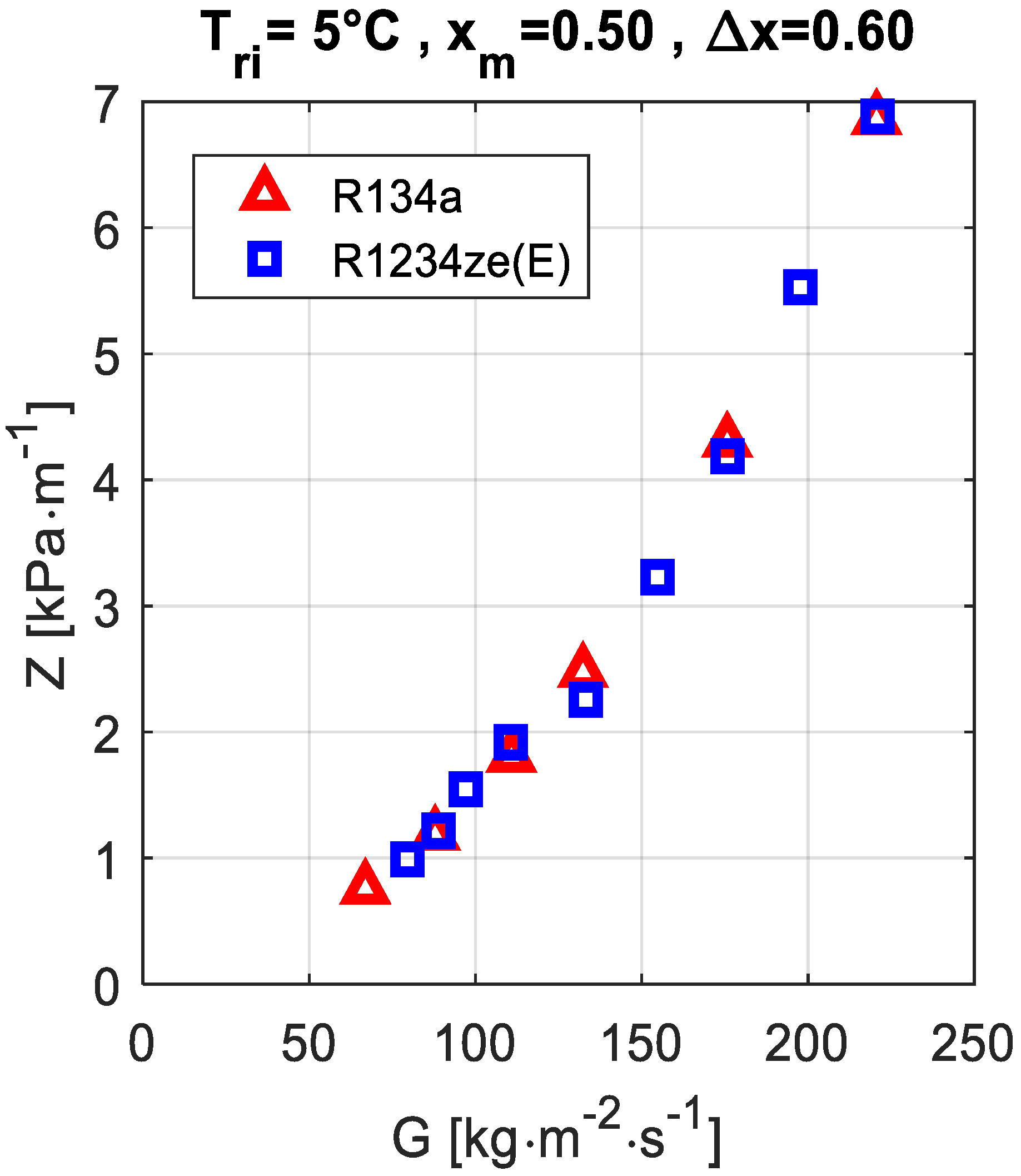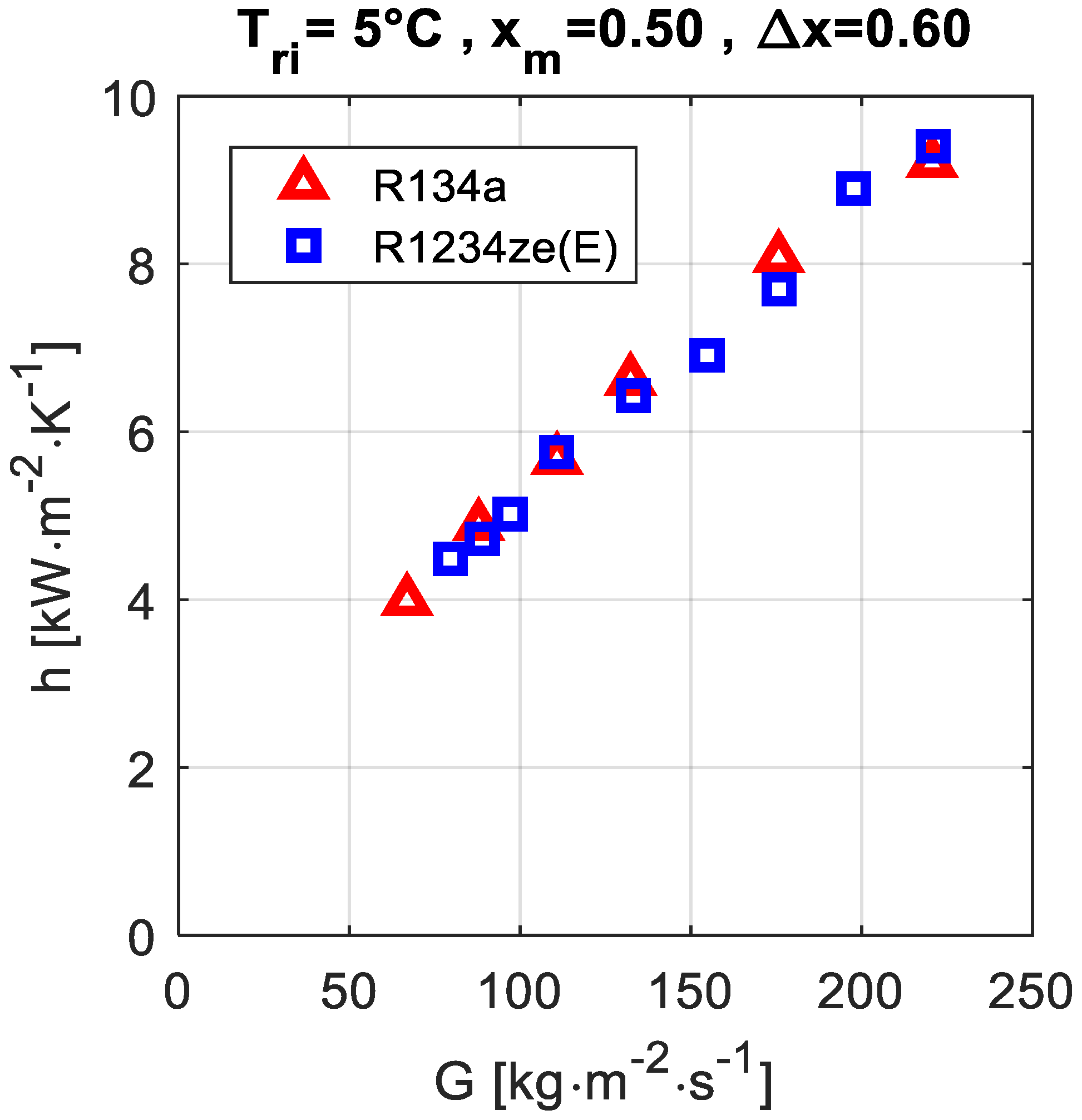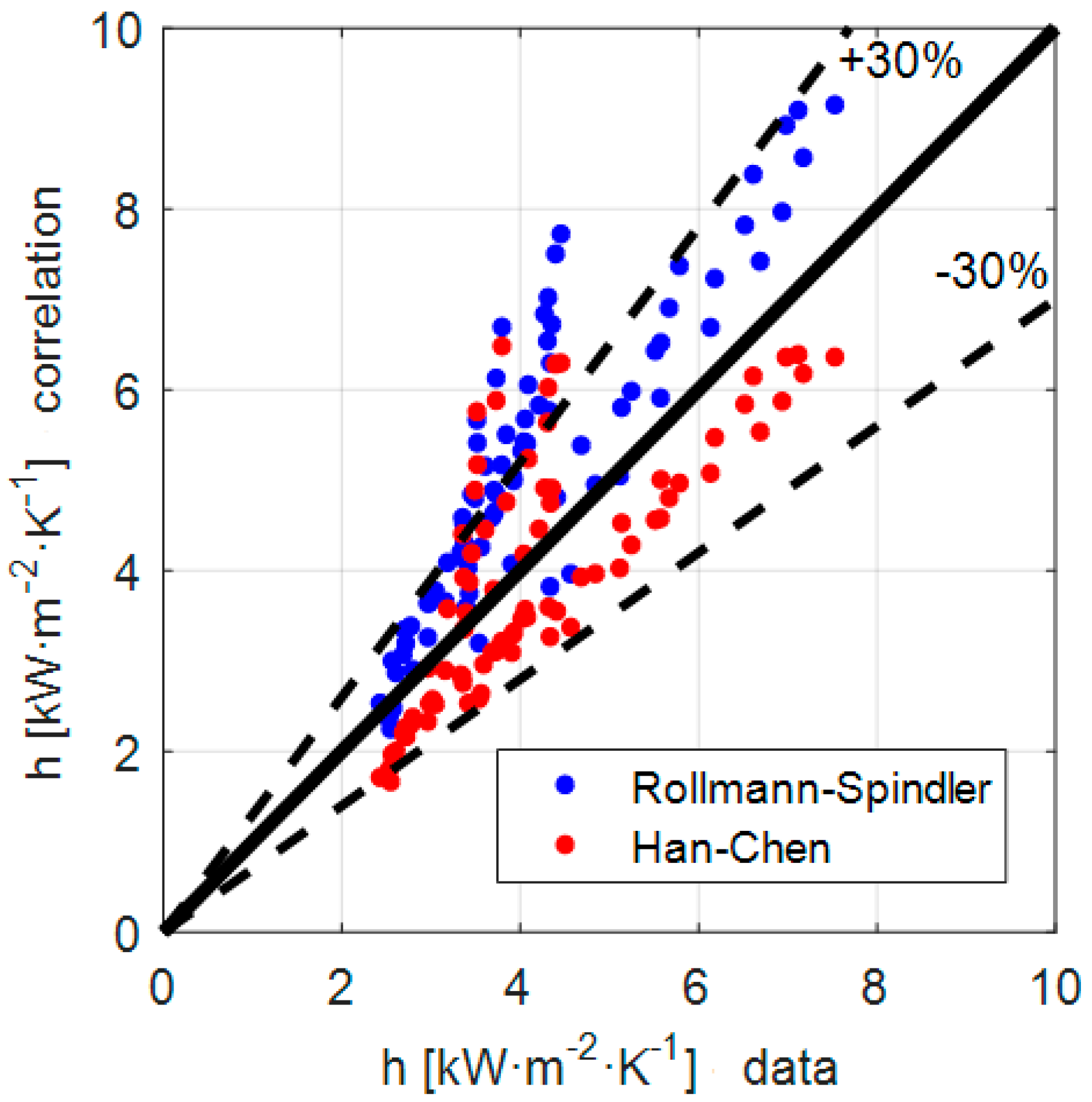1. Introduction
Increasing environmental concerns led the European Parliament to develop a roadmap to move to a competitive low carbon economy. Accordingly, the European Regulation (EU) No. 517/2014 [
1], dealing with fluorinated greenhouse gases and their replacement, prescribes progressive steps for the phase-out of HFC. The gradual elimination of the refrigerants commonly used in HVAC devices makes the search for new fluids suitable to prospective HVAC systems a top priority. In the near future, R134a will be banned and the hydro-fluoro-olefin (HFO) R1234ze(E) has been indicated as a promising alternative since its global warming potential (GWP) is much smaller (less than 1 for R1234ze(E) and 1430 for R134a [
2]) and its atmospheric lifetime is much shorter (17 days for R1234ze(E) and 13.8 years for R134a [
2]). In spite of such environmentally friendly features, drawbacks have also been reported [
3], mainly a slight flammability, and a negative impact on overall performance (mostly due to vapor compression efficiency). In recent years, the attention of the scientific community has been particularly focused on the assessment of performance variation due to the replacement of the fluids (the so-called drop-in replacement) at two different levels, namely the overall energy system (and/or its components), and the process (thermodynamics, transport phenomena). As significant examples of the former, Censi and Padovan [
3] examined a microfin shell and tube evaporator, showing 25% lower heat transfer rate for R1234ze(E) due to the same reduction in the volume flow rate but similar values of the overall heat transfer coefficient. Colombo et al. [
4] reported a 12.3% maximum reduction in the COP of a water-to-water heat pump compared to R134a. Zhang [
5] analyzed a plate heat exchanger highlighting that the HFOs refrigerants, compared to their HFC counterparts, show higher heat transfer coefficients and pressure drops when operating under the same conditions.
On the other hand, extensive investigations are reported for thermodynamic properties and transport phenomena. The following sample is closer to the subject of this paper than other literature contributions. Concerning fluid properties, Życzkowski et al. [
6] provided functional equations for R1234ze(E) property calculations, whereas Ghafri [
7] studied the thermodynamics properties of R1234ze(E) mixtures. Turning the attention to transport phenomena, Kedzierski and Park [
8] reported the heat transfer characteristics of the aforementioned refrigerants during flow boiling inside a microfin tube (8.92 mm inner diameter). The experiments revealed that R1234ze(E) has a lower heat transfer coefficient and the authors explained the results as a consequence of the higher thermal conductivity of R134a liquid phase. Goto et al. [
9] measured the heat transfer coefficient and pressure drop during condensation and evaporation of R410a and HCFC22 inside internally grooved tubes (either spiral groove or herring-bone groove). The results indicate that the herring-bone grooved tube is more effective in enhancing evaporation and condensation. Bandarra Filho et al. [
10] analyzed the pressure drop of refrigerant R134a under convective boiling conditions in horizontal smooth and micro-finned copper tubes. They found that good results can be obtained for smooth pipes, whereas a specific correlation was developed for the finned ones. Analogous work was done later on by Rollmann et al. [
11] and by Colombo et al. [
12], in which heat transfer coefficient and pressure drop for R134a were, respectively, studied. In both cases, as already noticed in previous studies, microfin tubes are characterized by a larger heat transfer coefficient and pressure drop than smooth tube, specifically as reported in [
12] during evaporation at low mass fluxes. Microfin tubes are particularly effective in increasing heat transfer and, moreover, the dry-out phenomenon takes place at larger qualities than in smooth pipes. Diani et al. [
13] compared the experimental values of heat transfer coefficient, frictional pressure drop, and vapor quality at the onset of dry-out against the values estimated by empirical correlations available in the open literature. The experiments performed in a 2.4 mm inner diameter microfin tube highlighted that, compared to an equivalent smooth tube, the microfin pipe presents an average enhancement factor of 2.4, which decreases as mass velocity and heat flux increase. Li [
14] performed a characterization of the R1234ze(E) in microchannels during evaporation.
To improve our understanding of the heat transfer features, many studies on flow patter maps during flow boiling and convective condensation have been performed. Their large number is related to the disagreement on the quantities that better describe the two-phase flow behavior. Specific to condensation, and worth mentioning, are the studies on flow visualization by Soliman [
15] and the flow pattern maps by Breber et al. [
16], Tandon et al. [
17], El Hajal et al. [
18], and Milkie et al. [
19]. For flow boiling analysis, studies to note are Kattan et al. [
20], Rollmann et al. [
21], Wojtan et al. [
22] (all of which are based on vapor quality x and mass flux G), and Zhuang et al. [
23], which is defined using the Martinelli parameter X
tt and the modified Weber number. As highlighted by Rollmann et al. [
21], the microfin tube shows a flow regime, named the helix flow, related to the helical structure of the microfins which cannot be observed in a smooth tube. Helix flow could be a possible explanation of the disagreement between the data and the predictions of the flow pattern maps and the correlations developed for the smooth tube when applied to the microfin tube. The main characteristic feature of the helix flow is the tangential motion of the refrigerant, as a consequence of the helical arrangement of the fins, that cause an asymmetrical distribution (referred to the vertical direction) of the liquid, which wets a larger portion of the tube perimeter than in the smooth tube at the same operating conditions. Eventually, Yang et al. [
24] also investigated the two-phase flow patterns and flow transitions for R1234ze(E) in a smooth horizontal tube with an inner diameter of 6 mm, highlighting the fact that the plug to slug and slug to annular transition are influenced by mass flux, heat flux, and saturation pressure.
During the years a large number of correlations were developed to predict the pressure drop and the heat transfer coefficient. Concerning the former, one of the first works was performed by Muller-Steinhagen and Heck [
25] in the 1980s. A more up-to-date work was published by Xu et al. [
26] in 2012, in which a comprehensive survey of correlations and experimental investigation of two-phase frictional pressure drop is reported. Worth mentioning is the work by Sun and Mishima [
27], published in 2008, in which correlations developed for refrigerants were taken into account and compared. In particular, the results show the accuracy of the Lockhart–Martinelli method, Mishima and Hibiki correlation, Zhang and Mishima correlation, and the Lee and Mudawar correlation in the laminar-laminar region is very close to each other, whereas the Muller-Steinhagen and Heck correlation is the best among the evaluated correlations in the turbulent-turbulent region. Moreover, in this paper, a modified Chisholm correlation was proposed, which resulted in better correlations than all of the previously evaluated ones with a mean relative error around 29%. Concerning the heat transfer coefficient, among the earliest correlations are the semi-empirical correlations by Murata et al. [
28] and Kattan et al. [
29], whereas the multi-variable regression analysis by Mehendale [
30] is one of the most recent (2018).
3. Data Reduction
Preliminary experiments checked if the thickness of the thermal insulation layer covering the evaporator, the calming section, and the test section was suitable to prevent too large thermal losses. Positive feedback came from the tests. The heating test, involving single phase vapor flow of refrigerant in the test section, highlighted that the power transferred, computed using the data of both the refrigerant and demineralized water, matched within ±5%. The complete evaporation test, involving the evaporator and the calming section, was performed tuning the thermal power of the evaporator such that the refrigerant entered as subcooled liquid and left as superheated vapor. The readings of the power-meter connected to the evaporator matched in a ±2% range with the power computed on the refrigerant enthalpy change and mass flow rate.
During the experiments, 12 acquisitions were performed for each operating condition. The single acquisition lasts for 180 s and records (with a sampling frequency of 1 Hz) the readings of all the devices connected to the acquisition board. At the end, 181 samples are stored for every quantity. Once the experiments are finished, a program (acquisition by acquisition) performs the post processing of the raw data. It mainly computes:
The pressure drop per unit length Z and the heat transfer coefficient h, for each single set of the 181 recordings;
The averages and the uncertainties related to each quantity using the 181 available values for each acquisition;
The averages and the uncertainties related to each quantity using the 12 available values for each operating condition (these values represent a single datapoint on a chart).
To check the probes, the test rig, and the computer programs, preliminary experiments were run involving single-phase vapor refrigerant flow inside a smooth tube. It was observed that the power transferred computed for both refrigerant side and water side matched within 5%. Moreover, the outcome of the post-processing agrees within ±5% with the most common correlations for heat transfer and pressure drop.
The post processing of the raw data aims to compute the values and the uncertainties of the parameter that identify the operating conditions and the outcomes of the analysis.
3.1. The Operating Conditions
Once the refrigerant fluid, the tube geometry and the type of experiments (flow boiling or convective condensation) are specified, the operating conditions are defined by four quantities:
The refrigerant inlet temperature in the test section TrTi;
The refrigerant mass flux G;
The quality change in the test section ∆x or the heat flux transferred in the test section q;
The mean quality in the test section xm.
The post processing, starting from the raw data, computes the above-mentioned quantities according to the following assumptions:
3.1.1. Refrigerant Inlet Temperature
The inlet temperature is determined as the saturation temperature corresponding to the refrigerant pressure at the test section inlet
prTi 3.1.2. Refrigerant Mass Flux
The refrigerant mass flow rate
is provided by the Coriolis flowmeter installed in the refrigerant loop, while the net cross-sectional area of the microfin tube, according to the nominal data in
Table 1, is:
their ratio provides the mass flux:
3.1.3. Quality Change and Heat Flux
As the two quantities are related only one can be fixed, the choice of the former or the latter depends on goal of the analysis: one should understand how the pressure drop per unit length and the heat transfer coefficient are affected by the heat flux or the flow regime (test performed keeping a constant quality change). To compute both the quantities the thermal power,
(transferred in the test section) is required:
the quality change is
while the heat flux, based on the heat transfer area related to the fin root diameter
DR, is:
3.1.4. Mean Quality
The mean quality in the test section is the sum of half of the quality change and the inlet quality. The energy balance on the evaporator, according to the hypothesis, provide the latter quantity
such that the mean quality is
3.2. The Outputs of the Post-Processing
Three are the main outputs of the post-processing: the pressure drop per unit length Z, the heat transfer coefficient h, and the uncertainty analysis for each measured or computed quantity.
3.2.1. Pressure Drop per Unit Length
The pressure drop per unit length is easily computed using the reading of the differential pressure transducer connected at the inlet and outlet of the test section and the distance between the pressure taps (
l = 1.3 m), their ratio provides:
3.2.2. Heat Transfer Coefficient
The determination of the refrigerant temperature at the test section outlet is the first step to compute the heat transfer coefficient. It is the saturation temperature corresponding the outlet pressure of the refrigerant (computed subtracting the pressure drop in the test section to the inlet pressure)
Two groups (one at the entrance and one at the exit of the test section) of three thermocouples are glued inside grooves (length 50 mm, depth 0.15 mm, width 0.4 mm) on the outside of the microfin tube (top, side, and bottom position). The average values of the readings given by the thermocouples of each group (Equation (7)) provide the inlet and outlet wall temperatures
The refrigerant temperatures and the wall temperatures are combined together to compute the logarithmic mean temperature difference
In the end the heat transfer coefficient is computed as the ratio of the heat flux (Equation (6)) and the logarithmic mean temperature difference
3.2.3. The Uncertainty Analysis
The uncertainty analysis was carried out using the error propagation algorithm, according to Moffat [
32], assuming that all of the quantities are statistically independent (the complete description of the procedure can be found in [
31]). The procedure showed that, for each datapoint, the uncertainty related to the parameters identifying the operating conditions, the pressure drop per unit length, and the heat transfer coefficient is lower than 5%.
